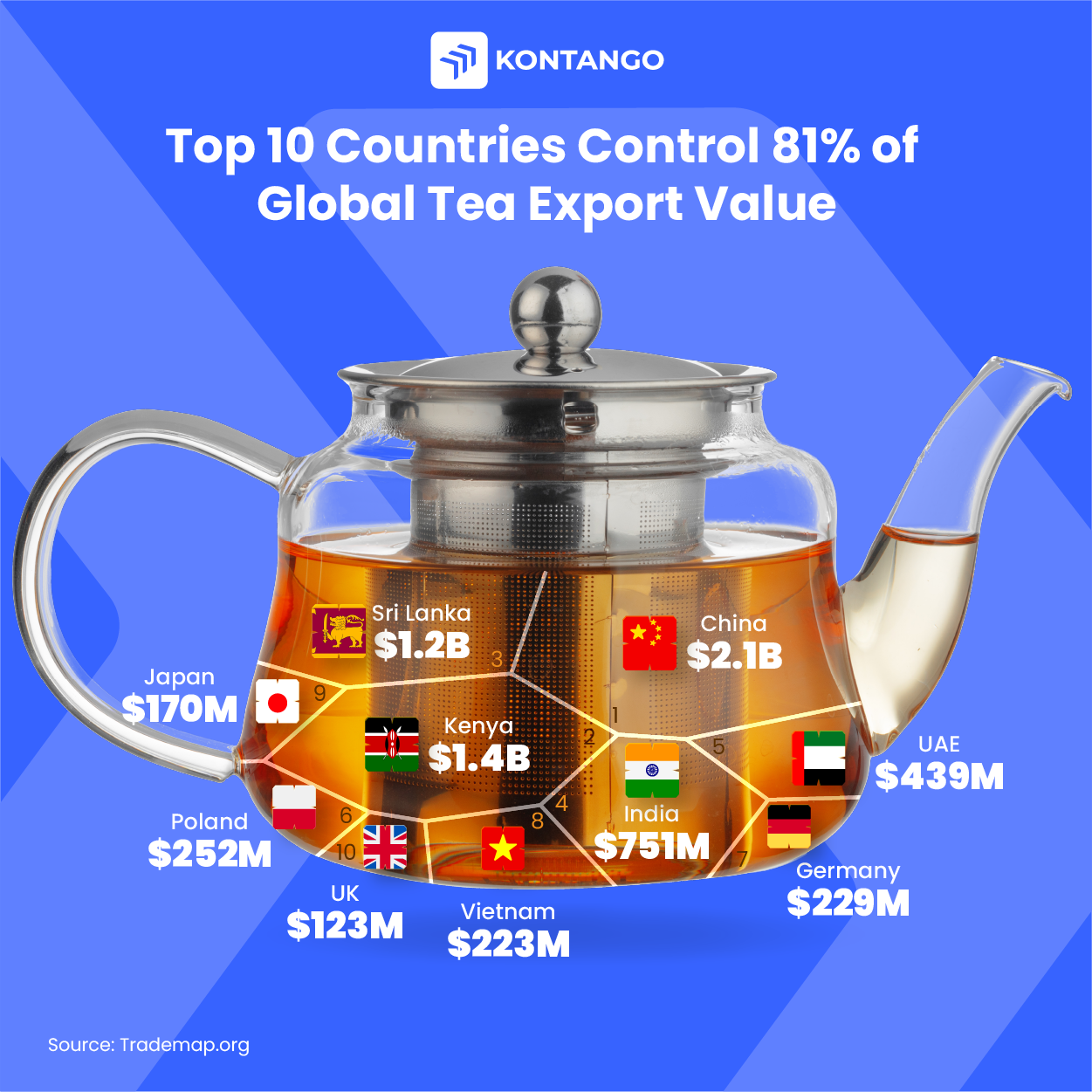Top 10 Countries Control 81% of Global Tea Export Value
In a clear demonstration of market concentration, the latest data from Trademap.org reveals a significant trend in the global tea export industry. Just ten countries now command an overwhelming 81% share of the global tea export market, underscoring their dominant economic roles in this sector. This concentration of market power not only reflects the strategic economic positions of these nations but also signals shifting patterns in global trade dynamics. From China's extensive exports to the emerging prominence of countries like Kenya and Sri Lanka, the tea market offers a nuanced view of global economic interactions, shaped by a blend of historical production capacities and modern trade strategies.
1. China: The Tea Titan
Leading the pack is China, with an export value of approximately $2.08 billion. Known as the birthplace of tea, China's diverse climate and rich cultural heritage have made it a powerhouse in tea production and export. The country's vast range of teas, from green to oolong, continues to captivate the global market.
2. Kenya: Africa's Tea Jewel
Kenya follows as the second-largest exporter, with exports worth around $1.39 billion. Kenya's tea industry is a critical component of its economy, and the country is renowned for its robust, aromatic black teas, which are highly sought after worldwide.
3. Sri Lanka: An Island of Tea
Sri Lanka, an island nation, holds the third spot, exporting tea worth approximately $1.23 billion. Known for its Ceylon tea, Sri Lanka has a rich history intertwined with tea production, characterized by its unique flavors and quality.
4. India: A Blend of Tradition and Modernity
India, with a tea export value of around $751 million, is another major player in the global tea market. Home to famous varieties like Assam and Darjeeling, Indian tea is celebrated for its distinct taste and quality.
5. United Arab Emirates: The Rising Hub
The United Arab Emirates, surprisingly, ranks fifth with exports totaling about $439 million. Its strategic location and robust trading infrastructure have made it a significant hub in the tea trade, despite not being a major tea producer.
6. Poland: Europe's Tea Trader
Poland comes in sixth with tea exports valued at approximately $253 million. Poland's position highlights the country's role as an important node in the European tea distribution network.
7. Germany: The Western Tea Connoisseur
Germany, with an export value of around $229 million, stands seventh. Its strong economy and a growing tea culture have positioned it as a key player in the Western tea market.
8. Vietnam: The Quiet Competitor
Vietnam, known for its green tea, ranks eighth with exports worth about $223 million. Vietnam's tea industry has seen significant growth, driven by its focus on quality and sustainability.
9. Japan: The Land of Green Tea
Japan, with exports totaling approximately $170 million, is ninth. Japan is celebrated for its high-quality green teas, such as matcha, which have gained international acclaim.
10. United Kingdom: The Traditional Market
Finally, the United Kingdom rounds out the top ten with tea exports worth about $123 million. The UK's long-standing tea culture and history as a former hub of the global tea trade reflect its continued significance in the market.
Conclusion
The dominance of these ten countries in the global tea export market is a clear indicator of the evolving landscape of international trade and economic influence. Their combined export power, capturing 81% of the market, highlights not only their agricultural and production strengths but also their ability to navigate and shape global trade networks. This trend in the tea market, reflective of broader economic shifts, underscores the importance of understanding how traditional commodities like tea can become pivotal in the interplay of global economic forces. As the world continues to witness changes in trade dynamics, the tea industry, led by these key players, remains a critical sector to watch for insights into global market trends and economic strategies.

